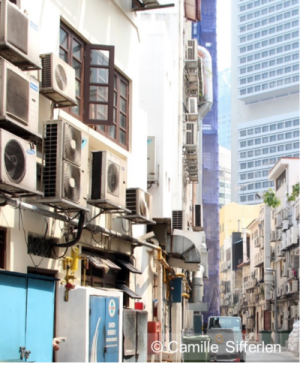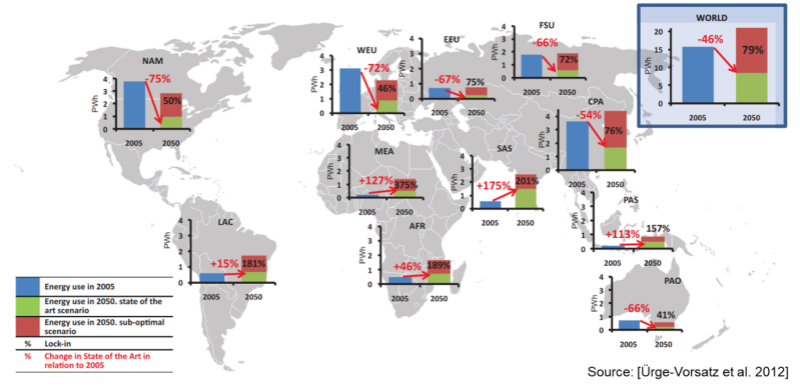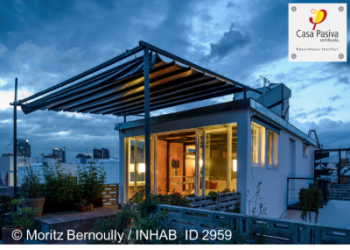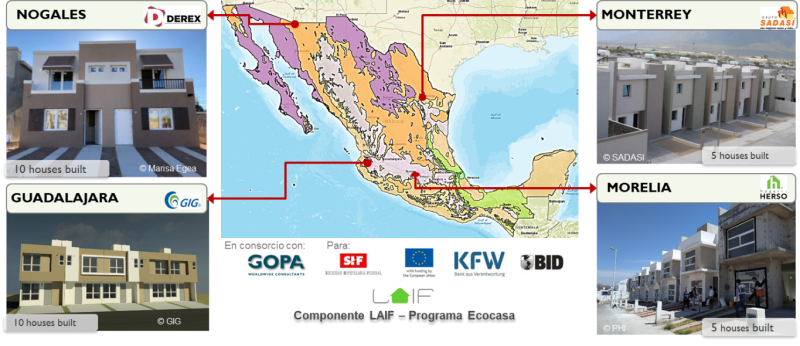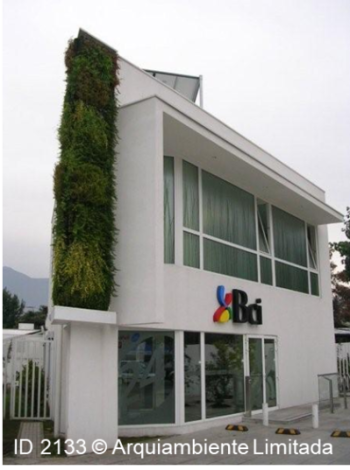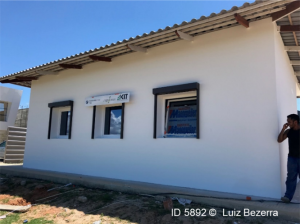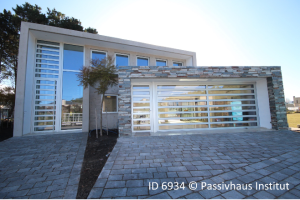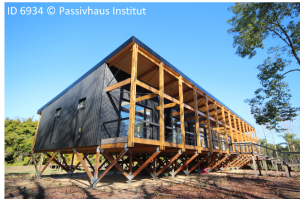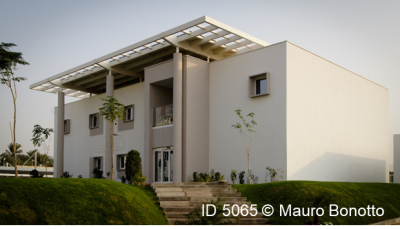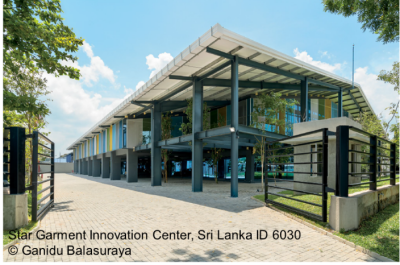Table of Contents
Passive House in the Global South?
For the purpose of this article we are borrowing the term “Global South” to group countries in emerging and developing countries where we are starting to see some interest and initial examples of Passive House.
It is important to talk about these regions, as they face not only climate change, but also a continued growth in population and a trend of rapid urbanisation. These often come together with a housing backlog, so there is an urgency for more housing possibilities. At the same time, the living standards must be improved and are rapidly changing in many of these countries. For all these reasons, and in combination with the effects of climate change, a continued increase in energy demand, especially for active cooling, is expected.
As shown in the map below, the Global Energy Assessment [Ürge-Vorsatz et al. 2012] revealed that employing sub-optimal solutions (business as usual) would lead to a substantial energy increase in many of these regions by mid-century, accompanied by a high risk of lock-in. On a worldwide scale, employing state of the art technologies indicates a reduction potential in energy the energy demand for heating and cooling of 46% compared to 2005 figures; and would prevent 79% energy needs (lock-in risk) compared with a sub-optimal development.
In other words, how high the increase in the energy demand will be for these regions will depend on the solutions that we implement today. So we need to start planning for high energy efficiency and avoid interim solutions. Luckily, Passive House has proven to be a viable solution for this that goes way beyond energy savings of the individual building – it can play a direct role in achieving many of the current sustainable global aims (for example the SDG’s as defined by the UN), among them health and comfort, equity and resilience [Tzar 2021].
So, how is Passive House looking in those regions?
In the framework of the plenary talk for the Passive House Network (formerly NAPHN) conference in June 2021, we took the chance to look at many of these countries and what has been done or is currently in progress regarding Passive House. Specifically, we looked at the countries classified by the International Monetary Fund [IMF Datamapper 2021] as emerging markets and developing economies – these are shown in the map below in darker shades of green. In many of them, local and international actors are already leading with examples, being pilot projects, a first Passive House or through studies – these are pinned in the map with different colors.
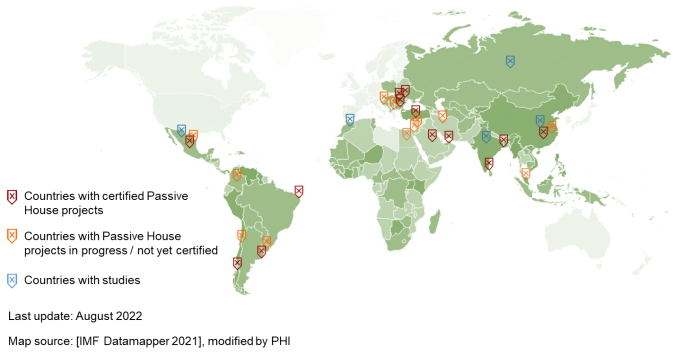
Case studies and example projects
Let’s quickly take a look at some examples (last updated in November 2023):
Mexico
For the last 10 years several institutions in the country have collaborated on the topic of energy efficiency. PHI, together with other partners, has participated through technical studies, development of tools and guidance for pilot projects. A summary of these initiatives is provided in the timeline below.
Some examples of the initiatives in the country are:
- The analyses carried out for the first Nationally Appropriate Mitigation Actions (NAMAs) for Sustainable Housing: showing that Passive House is the most economical option when looking at the costs during the whole life cycle of the building. And this holds true for different typologies, under different climate requirements and even on a present scenario where not all Passive House components are available in the market. This was carried out first for new-builds [PHI 2012] and second study shows that following a concept similar to the EnerPHit Retrofit Plan can guarantee high energy savings in retrofits [PHI 2015]. See also this article about the NAMAs.
- DEEVi Tool: The Passive House Planning Package (PHPP) is used as the basis for the tool used in the System to Evaluate Green Housing (SISEVIVE-ECOCASA) to assess the energy performance of housing projects receiving funding from different Mexican Institutions.
- A refurbishment in Mexico City was certified as a Passive House in 2014, becoming the first Passive House in Latin America.
- Pilot projects - New housing: Thanks to the LAIF Component of the Ecocasa Programme there are now around 30 pilot projects of social housing built to the Passive House standard. These are located in hot climates like Monterrey and Nogales, but also in milder climates like Guadalajara and Morelia. You can learn more about the project here and read about the first experiences on Blower Door testing here.
- Pilot projects - Existing housing: From 2019 to 2023 the GIZ (German International Cooperation, an initiative of the BMZ (Federal Ministry for Economic Cooperation and Development)), with the help of the team of Gopa, IzN and PHI implemented successfully first steps to sustainably retrofit 30 social housing units in challenging climates Mexicali and Hermosillo. The approach follows the EnerPHit methodology. The “DKTI” project was presented at the 26th International Passive House Conference in Wiesbaden, Germany [Rodriguez Beele 2023], and the final project report can be downloaded here (in Spanish) directly or from the official Mexican website: Cooperación Clima, direct link: Cooperación Clima
Chile
The first pilot project in Latin America was an office building in Vitacura, Santiago constructed in 2010. In february 2024, the first residential Passive House in Chile got certified, see ID 7512 in the Passive House database. Due to the commitment of dedicated individuals and organisations driving awareness regionally, we are now seeing more and more projects such as single family homes and multi-family buildings coming up and in the process of being certified.
Brazil
The first Passive House in Brazil is a learning facility from 2017. Financed by the German Ministry of Education and Research (BMBF) in partnership with SENAI – RN, RLP Agroscience GmbH, HWK Trier and KIT Karlsruhe, this project is one of many great examples of collaboration between local and international actors who go through a steep learning curve to build a pilot Passive House building.
Argentina
Two projects have been certified in Argentina in 2022, both located in the province of Buenos Aires. One is a single-family home in Mar del Plata, the other one is a weekend home located deep in the Tigre Delta.
United Arab Emirates
The first Passive House in UAE is an office building in Dubai, constructed in 2016 for the Mohammed Bin Rashid Space Centre, a governmental research body. It was designed for energy independence, and preliminary monitoring showed positive results in terms of indoor comfort and air quality [Filippi 2019].
Sri Lanka
Another project where monitoring data has provided proof of concept is the pilot project in Sri Lanka. It is not only one of the few projects located in a tropical monsoon climate, but a great example of how a renovation can integrate the way people work and construct locally while achieving high energy efficiency.
India
- In 2016, a short study explored savings through better windows, by switching to plastic frames with double or triple low-E glazing in the climate of New Delhi.
- A similar analysis to the ones carried out for Mexico confirms that Passive house is technically and economically feasible in many different climate zones in India, even in current market conditions, where many components are not locally available. The image below includes an example from this study. More details regarding the Passive House buildings are also available on Passipedia, and the results of these study, as well as the prototypes to the Passive House level were published as part of a Catalogue of Replicable Designs available online.
- Ice Box Challenge run in Delhi 2024 to raise awareness on energy efficiency measures to reduce cooling needs.
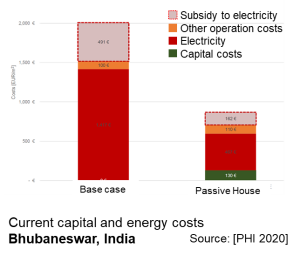 | 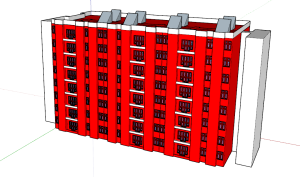 |
| Figure 12 Example of the capital and energy costs for one of the prototypes of multi-family buildings in India | |
Morocco
A short course and two preliminary studies supported by GIZ Morocco have helped to identify the components that would be required in some climatic zones in the country.
Summing up
These are just some selected examples. More projects and studies are underway and we expect soon to see the first certified projects in many other countries, for example: Iraq, Malaysia, Jordan, Colombia, Uruguay and Egypt.
Studies are a great way to show that Passive House is not only technically but economically feasible for different typologies and in a variety of climates. They can pave the way by showing technical solutions and sparking interest in the regional market. Ultimately, pilot projects are the best way to show how the performance values of the Passive House criteria can be successfully incorporated to respond to local requirements and designs. Nothing is more convincing than walking into a Passive House and experiencing firsthand comfort and better air quality.
References
| [Filippi 2019] | Filippi, Marco. Pilot Passive House in UAE – Results from Monitoring. Conference Proceedings from the 23rd International Passive House Conference 2019. |
| [IMF Datamapper 2021] | International Monetary Fund. IMF Datamapper. Map retrieved in June 2021 from https://www.imf.org/external/datamapper/NGDP_RPCH@WEO/OEMDC?year=2021 |
| [Passive House Database] | Common project of the Passive House Institute, the Passivhaus Dienstleistung GmbH, the IG Passivahaus Deutschland and the iPHA and Affiliates. Retrieved in August 2022 from https://passivehouse-database.org/ |
| [PHI 2012] | Passive House Institute. Technical Annex: Evaluation of social housing building types in Mexico. For the Supported NAMA for Sustainable Housing in Mexico – Mitigation Actions and Financing Packages. October 2012. https://passivehouse.com/05_service/03_literature/0302_cost-effectiveness/030202_energy-efficiency_sustainable-housing_Mexico.htm |
| [PHI 2015] | Theumer, Susanne; Riverio Arias, María del Carmen. Cost-optimised Standard for Social Housing Retrofit in Mexico: EnerPHit. Conference proceedings of the 19th International Passive House Conference. Passive House Institute, 2015 |
| [Rodriguez Beele 2023] | Rodriguez-Kuri, Salvador; Beele, Albert. Demonstrative project of step-by-step energy retrofit of social housing in hot dry climate of Mexico. Conference proceedings of the 19th International Passive House Conference. Conference Proceedings from the 26th International Passive House Conference 2023. |
| [Tzar 2021] | Tzar, Giorgia Passive House and the Sustainable Development Goals (SDG’s): Connecting an international building standard with global aims. In Passsipedia, the Passive House Resource. 2021. https://passipedia.org/basics/passive_house_and_the_sustainable_development_goals |
| [Ürge-Vorsatz et al. 2012] | Ürge-Vorsatz D, Eyre N, Graham P, Harvey D, Hertwich E, Jiang Y, Kornevall C, Majumdar M, McMahon JE, Mirasgedis S, et al.: Energy End-Use: Buildings. In Global Energy Assessment - Towards a Sustainable Future. Edited by Johansson TB, Nakicenovic N, Patwardhan A, Gomez-Echeverri L. Cambridge University Press; 2012:649–760. |

